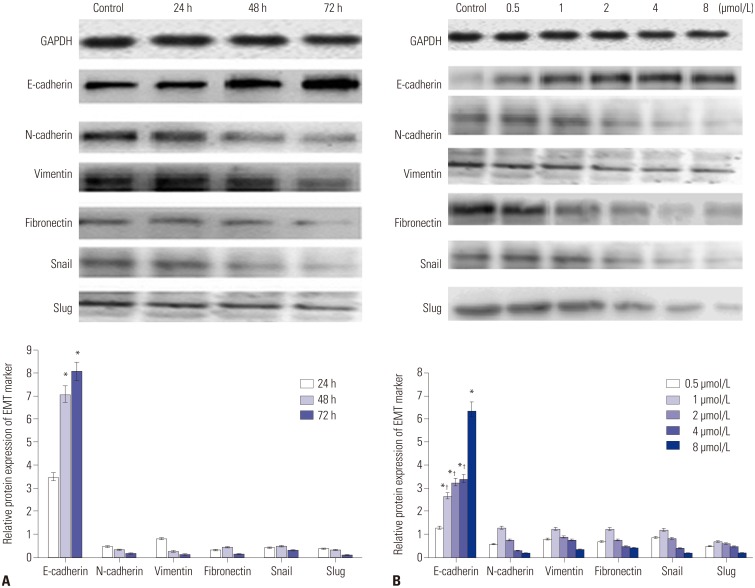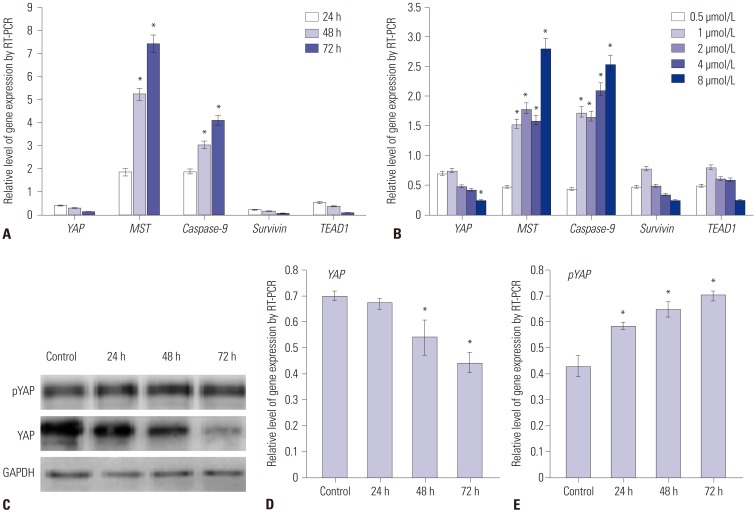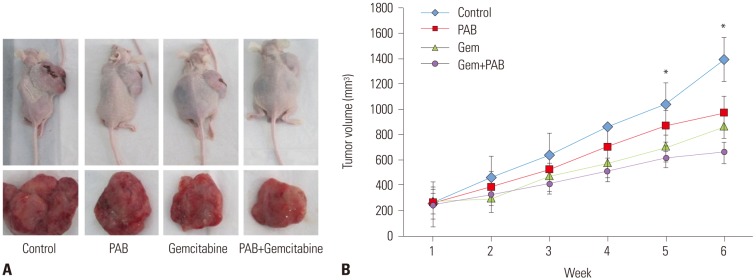Yonsei Med J.
2018 Jan;59(1):20-27. 10.3349/ymj.2018.59.1.20.
Pseudolaric Acid B Inhibits Proliferation, Invasion and Epithelial-to-Mesenchymal Transition in Human Pancreatic Cancer Cell
- Affiliations
-
- 1Department of Gastroenterology, The Affiliated Hospital of Qingdao University, Qingdao, Shandong, China. zhangcuiping753357@163.com
- 2Department of Infectious Diseases, The Affiliated Hospital of Qingdao University, Qingdao, Shandong, China.
- 3Department of Hepatobiliary Surgery, The Affiliated Hospital of Qingdao University, Qingdao, Shandong, China.
- KMID: 2418844
- DOI: http://doi.org/10.3349/ymj.2018.59.1.20
Abstract
- PURPOSE
This study was aimed to investigate the effect of pseudolaric acid B (PAB) on proliferation, invasion and epithelial-to-mesenchymal transition (EMT) in pancreatic cancer cells and to explore the possible mechanism.
MATERIALS AND METHODS
The pancreatic cancer cell line SW1990 was cultured and treated with PAB dose- and time-dependent manners. Cell proliferation and invasion ability were measured by MTT assay and Matrigel/Transwell test, respectively. Semi-quantitative real-time polymerase chain reaction and Western blotting were conducted to detect the expression of EMT markers and the key molecules. Finally, nude mice subcutaneous transplantation tumor model was used to confirm the therapy efficacy of PAB.
RESULTS
PAB could inhibit SW1990 cell proliferation and invasion in time- and dose-dependent manners. Vimentin, fibronectin, N-cadherin, Snail, Slug, YAP, TEAD1, and Survivin were down-regulated (p < 0.01), while E-cadherin, caspase-9, MST1, and pYAP were up-regulated (p < 0.05). Combined PAB and gemcitabine treatment markedly restricted the tumor growth compared with gencitabin or PAB alone groups.
CONCLUSION
PAB could inhibit the proliferation and invasion ability of pancreatic cancer cells through activating Hippo-YAP pathway and inhibiting the process of EMT.
Keyword
MeSH Terms
-
Animals
Antineoplastic Agents/pharmacology/therapeutic use
Biomarkers, Tumor/metabolism
Cadherins
Cell Line, Tumor
Cell Movement
Cell Proliferation/drug effects
Cytokines
Deoxycytidine/analogs & derivatives/pharmacology/therapeutic use
Diterpenes/pharmacology/*therapeutic use
Epithelial-Mesenchymal Transition/*drug effects
Female
Humans
Mice, Nude
Neoplasm Invasiveness
Pancreatic Neoplasms/*diet therapy/*pathology
Real-Time Polymerase Chain Reaction
Signal Transduction/drug effects
Vimentin/metabolism
Antineoplastic Agents
Biomarkers, Tumor
Cadherins
Cytokines
Diterpenes
Vimentin
Deoxycytidine
Figure
Reference
-
1. Siegel RL, Miller KD, Jemal A. Cancer statistics, 2015. CA Cancer J Clin. 2015; 65:5–29. PMID: 25559415.
Article2. Chen W, Zheng R, Baade PD, Zhang S, Zeng H, Bray F, et al. Cancer statistics in China, 2015. CA Cancer J Clin. 2016; 66:115–132. PMID: 26808342.
Article3. Long J, Luo GP, Xiao ZW, Liu ZQ, Guo M, Liu L, et al. Cancer statistics: current diagnosis and treatment of pancreatic cancer in Shanghai, China. Cancer Lett. 2014; 346:273–277. PMID: 24462819.
Article4. Yang YM, Yang WX. Epithelial-to-mesenchymal transition in the development of endometriosis. Oncotarget. 2017; 8:41679–41689. PMID: 28415639.
Article5. Gu W, Liu W, Shen X, Shi Y, Wang L, Liu H. Emergence of heterogeneous nuclear ribonucleoprotein A2/B1 vs loss of E-cadherin: their reciprocal immunoexpression profiles in human pancreatic cancer. Ann Diagn Pathol. 2013; 17:14–17. PMID: 22622045.
Article6. Yao GD, Yang J, Li Q, Zhang Y, Qi M, Fan SM, et al. Activation of p53 contributes to pseudolaric acid B-induced senescence in human lung cancer cells in vitro. Acta Pharmacol Sin. 2016; 37:919–929. PMID: 27041461.
Article7. Yu J, Chen C, Xu T, Yan M, Xue B, Wang Y, et al. Pseudolaric acid B activates autophagy in MCF-7 human breast cancer cells to prevent cell death. Oncol Lett. 2016; 11:1731–1737. PMID: 26998069.
Article8. Yu J, Ren P, Zhong T, Wang Y, Yan M, Xue B, et al. Pseudolaric acid B inhibits proliferation in SW579 human thyroid squamous cell carcinoma. Mol Med Rep. 2015; 12:7195–7202. PMID: 26460192.
Article9. Sun Q, Li Y. The inhibitory effect of pseudolaric acid B on gastric cancer and multidrug resistance via Cox-2/PKC-α/P-gp pathway. PLoS One. 2014; 9:e107830. PMID: 25250794.
Article10. Zheng X, Carstens JL, Kim J, Scheible M, Kaye J, Sugimoto H, et al. Epithelial-to-mesenchymal transition is dispensable for metastasis but induces chemoresistance in pancreatic cancer. Nature. 2015; 527:525–530. PMID: 26560028.
Article11. Rhim AD, Mirek ET, Aiello NM, Maitra A, Bailey JM, McAllister F, et al. EMT and dissemination precede pancreatic tumor formation. Cell. 2012; 148:349–361. PMID: 22265420.
Article12. von Burstin J, Eser S, Paul MC, Seidler B, Brandl M, Messer M, et al. E-cadherin regulates metastasis of pancreatic cancer in vivo and is suppressed by a SNAIL/HDAC1/HDAC2 repressor complex. Gastroenterology. 2009; 137:361–371. PMID: 19362090.
Article13. Scheel C, Weinberg RA. Cancer stem cells and epithelial-mesenchymal transition: concepts and molecular links. Semin Cancer Biol. 2012; 22:396–403. PMID: 22554795.
Article14. Wu K, Zeng J, Zhou J, Fan J, Chen Y, Wang Z, et al. Slug contributes to cadherin switch and malignant progression in muscle-invasive bladder cancer development. Urol Oncol. 2013; 31:1751–1760. PMID: 22421353.
Article15. Vesuna F, van Diest P, Chen JH, Raman V. Twist is a transcriptional repressor of E-cadherin gene expression in breast cancer. Biochem Biophys Res Commun. 2008; 367:235–241. PMID: 18062917.
Article16. Lamar JM, Stern P, Liu H, Schindler JW, Jiang ZG, Hynes RO. The Hippo pathway target, YAP, promotes metastasis through its TEAD-interaction domain. Proc Natl Acad Sci U S A. 2012; 109:E2441–E2450. PMID: 22891335.
Article17. Yang N, Morrison CD, Liu P, Miecznikowski J, Bshara W, Han S, et al. TAZ induces growth factor-independent proliferation through activation of EGFR ligand amphiregulin. Cell Cycle. 2012; 11:2922–2930. PMID: 22825057.
Article
- Full Text Links
- Actions
-
Cited
- CITED
-
- Close
- Share
- Similar articles
-
- Membrane Proteins Involved in Epithelial-Mesenchymal Transition and Tumor Invasion: Studies on TMPRSS4 and TM4SF5
- Effect of Resveratrol on Oral Cancer Cell Invasion Induced by Lysophosphatidic Acid
- Parthenolide inhibits transforming growth factor β1-induced epithelial-mesenchymal transition in colorectal cancer cells
- Pancreatic Cancer and MicroRNAs
- MicroRNA-373 Inhibits Cell Proliferation and Invasion via Targeting BRF2 in Human Non-small Cell Lung Cancer A549 Cell Line





